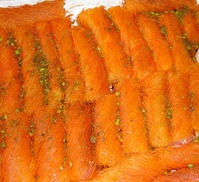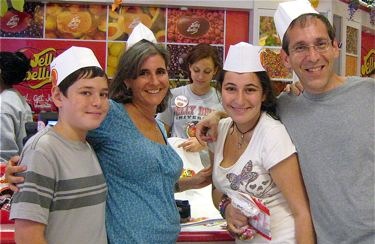
 I’ll admit it: I’m afraid of East Jerusalem. The reason isn’t that hard to discern. It wasn’t so long ago that an Israeli Jew who found himself lost in the Arab part of the city could be stoned, pulled out of the car and attacked.
I’ll admit it: I’m afraid of East Jerusalem. The reason isn’t that hard to discern. It wasn’t so long ago that an Israeli Jew who found himself lost in the Arab part of the city could be stoned, pulled out of the car and attacked.
These days, though, East Jerusalem is mostly safe and filled with tourists searching for the best kanafeh, a syrup-drenched cheese and dough dessert.
Still, it was with a certain amount of trepidation that Jody and I visited East Jerusalem not once but twice over the last two weeks.
The first trip was part of Jerusalem’s remarkable “Houses from Within†event. Every year, the city opens up tens of normally private homes and institutions to the public, all for free.
Last year we visited the light rail depot in Pisgat Ze’ev (see my article here). For 2009, we chose the Center for Near Eastern Studies (aka, the Jerusalem branch of the Mormon-run Brigham Young University).
The center is architecturally stunning, full of teak, marble and Jerusalem Stone. A sculptured fountain bubbles down several floors. There are lovely gardens, complete with a working replica of an Abrahamic-era olive press for the students who come from BYU for a semester to operate as part of their overall Israel “experience.†The 125,000 square foot center can house up to 170 students on eight levels.
But the main selling point for the center is the view. It hits you the instant you walk through the floor-to-ceiling double doors. Through a magnificent arched window, the city unfolds from a perspective rarely seen by most Israelis. BYU is situated on Mount Scopus and looks out at the Mount of Olives and the Old City from the east, with the “skyscrapers†of west Jerusalem rising in the background.
The view is best savored from a seat in the center’s concert hall, which features “the largest pipe organ in the Middle East.†Our 45-minute tour included a 10-minute musical history lesson and recital from the organ master. Concerts are held regularly during the year and are open to the public.
The last time I heard a huge pipe organ was at a local eatery growing up called “Pizza and Pipes.†This was better.
At the end of the tour, a young Israeli couple asked our guide for more information about the Mormon Church. The guide refused to answer. According to an agreement cut with the Israeli government some 20 years ago when permission was given to build the center, students and faculty are not allowed to proselytize. Apparently that means even giving a modicum of background.
I remember that controversy; it was during the time when I first arrived in Israel. The religious parties were up in arms and the center’s very establishment seemed in doubt.
The Israeli couple was quite insistent. The guide declined several times before referring them to the BYU website. Were they interested in conversation…or conversion, I wondered? I chose not to ask.
Our second foray into East Jerusalem came a few days later when we were invited to a multi-faith post-Ramadan Iftar meal at the home of Sheikh Ghassan Menasra just east of Wadi Joz.
The Sheikh has been active in the Nava Tehila Beit Midrash and invited members of the Jerusalem-based Jewish Renewal community to join him at his home for the traditional break-fast meal.
There were about 50 of us crammed into two small rooms. For some reason, I had expected someone as important as a “Sheikh†to live in a palatial home, but Ghassan’s house was modest and worn around the edges.
We removed our shoes and sat on the floor. In the center was a plastic tablecloth with plates full of rice topped with yogurt, stuffed grape leaves, sweet potato paste, pita, and cucumber and tomato salad.
The most interesting part of the evening was not the meal but getting there. Remember my trepidation about getting stuck in East Jerusalem? Well, that’s pretty much what happened. We left in a convoy of about 5 cars starting from Liberty Bell Park. The traffic was horrendous and we – being at the end of the chain – got separated.
The problem – for those of you familiar with the area – is that we turned left on Wadi Joz Street when we should have gone straight into the Wadi Joz neighborhood itself.
We stopped pedestrian after pedestrian seeking instruction. We were told to find the Commodore Hotel and the Sheikh’s home would be up the hill from there. But, of course, there was no Commodore in the direction we took. It was like being in Oz, with each passerby acting like a toughed up version of the scarecrow.
All the while, I was getting more and more nervous as the sun began to set. Completely lost in East Jerusalem, who’s to say we wouldn’t drive into the really wrong part of town and…
After close to 45 minutes, we found the hotel and shortly afterward parked at a dead end and hiked up a dirt path to the Sheikh’s house. Ghassan welcomed us warmly but we were embarrassed walking in well past the sunset start of the meal. Imagine stretching the Yom Kippur fast out for an extra hour. Fortunately they didn’t wait for us stragglers.
On the way up, my co-pilot – who has some experience in East Jerusalem – pointed out an establishment which he said sells the best kanafeh in town. Now that we know the lay of the land better, maybe we’ll come back for dessert some day.
Or then again, maybe not.
—————
The Jerusalem Center for Near Eastern Studies is open to the public for tours. Contact them at +972-2-626-5666.

